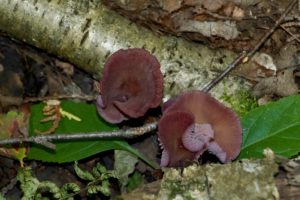Written by Nancy Nabak, Communication Coordinator
As our birds are getting ready to head south for the winter, this is also the time that fungus starts popping up in brilliant forms and colors everywhere.
 I’m a birder at heart, but when it turns to mushroom season, it’s like a new species migration for me. The neat thing is, these little fellas don’t have to travel thousands of miles to show up. They’re right here, waiting for the perfect mix of temperature, moisture, sun, and seasonal calendar to let you know they’ve arrived.
I’m a birder at heart, but when it turns to mushroom season, it’s like a new species migration for me. The neat thing is, these little fellas don’t have to travel thousands of miles to show up. They’re right here, waiting for the perfect mix of temperature, moisture, sun, and seasonal calendar to let you know they’ve arrived.
Fungus is one of the coolest concepts in the living world. Both below the ground and above. Above ground, you see the sporing fruit, the mushroom. Below ground exists a root network called mycelium. Some mycelium “roots” can be up to thousands of acres in length. Furthermore, this fascinating miniature world has also learned to communicate through electrical impulses.
There is so much to learn and know about fungi and especially mushrooms, but as a visual person, I enjoy the variety of colors and textures. When taking hikes at this time of year, it’s easy to spot yellow, orange, violet, brown, and white mushrooms. You can also find ones that look like coral, gummy candy, cottage cheese, and fingers of a dead man reaching out from the ground – so perfect for Halloween time.
Many people want to know which mushrooms are edible and which aren’t. The general rule is assume they’re all deadly. Never eat any of them raw. Find an expert or consult guides to prepare yourself before foraging.
The more I learn about mushrooms and identification, the more fascinated I am. Some caps may be concave, pointed, smooth, scaly or slimy. Some stems or stipes may have a veil. Some caps may have an underside that is gilled, porous, or “toothed.” And in all of it, I love the fact that I have to slow down, lay down at eye level, and try to learn as much as I can. Some mushrooms have certain smells that help identify them – including a fresh cherry smell or cinnamon. However, in many cases, identification can only be done by chemical testing or spore prints.
Back to being a bird nerd, while on my mushroom hikes, I’m now on a quest to find Nidulariaceae, or bird’s nest fungus. This fungus closely resembles a tiny egg-filled birds’ nest. What a winning combination.
After all of the rain we’ve had lately followed by sunshine, give yourself a treat and go look for some fascinating fungi. Walk slowly. Please, if you find the bird’s nest, give me a call at Woodland Dunes so we can share in the joy.
Photo: Amethyst Deceiver by Nancy Nabak
